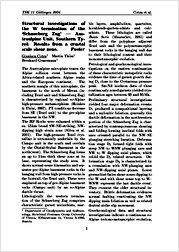Structural investigations of the W termination of the ‘Schneeberg Zug’ — Austroalpine Unit, Southern Tyrol: Results from a crustal scale shear zone
Cotza, Gianluca
Thöni, Martin
Grasemann, Bernhard
Universitätsverlag Göttingen
Sammelband- / Konferenzbeitrag
Verlagsversion
Deutsch
Cotza, Gianluca; Thöni, Martin; Grasemann, Bernhard, 2006: Structural investigations of the W termination of the ‘Schneeberg Zug’ — Austroalpine Unit, Southern Tyrol: Results from a crustal scale shear zone. In: Philipp, S.; Leiss, B; Vollbrecht, A.; Tanner, D.; Gudmundsson, A. (eds.): 11. Symposium "Tektonik, Struktur- und Kristallingeologie"; 2006, Univ.-Verl. Göttingen, S. 33 - 34., , DOI: 10.23689/fidgeo-1899.
 |
Dokument öffnen: |
The Austroalpine microplate traces the
Alpine collision event between the
Africa-related southern Alpine realm
and the European continent. The
southern margin of this microplate, the
basement to the north of Meran (including
Texel unit and Schneeberg Zug)
is characterized by regional eo-Alpine
high-pressure metamorphism (Hoinkes
& Thöni, 1987). PT conditions decrease
from SE (Texel unit) to the pre-alpine
basement in the NW.
The HP Rocks were exhumed within a
ca. 15km broad SW-NE-striking, NWdipping
high strain zone (Sölva et al.
2001). The high-pressure Texel crystalline
is tectonically underlain by the
Campo unit in the south and overlain
by the Ötztal-Stubai Basement in the
north(west). The Schneeberg Zug forms
an up to 5km thick shear zone at its
base, representing the study area. It
shows normal-sense kinematics and separates
pre-Alpine basement rocks in the
hanging wall from high-pressure rocks in
the footwall, the Texel unit. These were
emplaced on top of pre-Alpine basement
rocks (Campo unit) by an eo-Alpine
ductile thrust.
Lithologically the western termination
of the Schneeberg Zug comprises
characteristic garnet micaschists, marble
layers, amphibolites, quartzites,
hornblende-garben-schists and calcschists.
These lithologies are called
Bunte Serie (Mauracher, 1981) and
differ from the polyphase adjacent
Texel unit and the polymetamorphic
basement rocks in the hanging wall due
to their lithological content and their
monometamorphic evolution.
Petrological and geochronological investigations
on the eastern continuation
of these characteristic metapelitic rocks
evidence the time of garnet growth during
D1 close to the Cretaceous pressure
peak. Sm-Nd isochron data of these
continuously zoned garnets yielded crystallization
ages between 90 and 95 Ma.
Preliminary structural investigations
yielded four major deformation events:
D1 produced a compositional layering
and a mylonitic foliation; generally this
ductile deformation in the northwestern
portion of the Schneeberg Zug is characterized
by contemporaneous shearing
and folding forming isoclinal folds with
axes oriented parallel to the NW–SE
plunging stretching lineation. Deformation
stage D2 formed tight folds with
steep NW to WSW plunging axes and
NW to W dipping axial planes, which
refold the D1 related structures. Deformation
stage D3 is characterized by
a crenulation with NW-plunging axes
and NW-dipping axial planes. Lower
greenschist-facies shear-zones dipping to
the W and with shear sense top to W–
WNW represent the last ductile event.
They crosscut the older structural inventory.
Brittle deformation evidences
normal faulting reactivating the NW
dipping main foliation as well as related
dextral strike slip movement.
Geochronological data and structural
investigations indicate a continuous eo-
Alpine tectono-metamorphic evolution,
which started at high grade conditions
homogenously distributed over the
whole shear zone. With decreasing
temperature conditions the deformation
progressively partitioned into distinct
shear zones.

